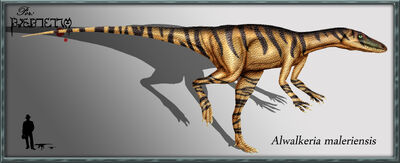Alwalkeria ( "for Alick Walker") is a genus of basal saurischian dinosaur from the Late Triassic of India. It was a small bipedal omnivore.
This dinosaur was originally named Walkeria maleriensis by Sankar Chatterjee in 1987, in honor of famous British paleontologist Alick Walker and the Maleri Formation, in which its fossils were found. However, the original generic name was found to be preoccupied by a bryozoan. A new name was created in 1994 by Chatterjee and Ben Creisler.
Remains of Alwalkeria have been recovered from the Maleri Formation of Andhra Pradesh, India. This is a Late Triassic geologic formation. Indeterminate prosauropod material has also been found in the Maleri, but Alwalkeria is the only named dinosaur species. The one known specimen is partial and consists of parts of the front ends of the upper and lower jaws, 28 incomplete vertebrae from all parts of the spinal column, most of a femur (thigh bone), and an astragalus (ankle bone). The partial skull is about 4 centimeters long (1.5 in).
Although material of Alwalkeria is limited, the spacing and shape of the teeth strongly resemble those of Eoraptor. As in Eoraptor, a gap separates the teeth of the premaxillary and the maxillary bones of the upper jaw. Other similarities in the skull of the two animals also link them on morphologic grounds (Langer 2004).
Alwalkeria has not been included in a cladistic analysis, but its similarities to Eoraptor suggest it may have held a similar position in the dinosaur family tree. However, the position of Eoraptor is disputed. One recent analysis finds it within the order Saurischia, but basal to the Theropoda-Sauropodomorpha split (Langer 2004). Paul Sereno finds instead that Eoraptor is a basal theropod (Sereno 1999). Others place Eoraptor outside of Dinosauria completely (Fraser et al. 2002).
This dinosaur also has a heterodont dentition in the upper jaw, meaning that the teeth are differently shaped depending on their position within the jaw. Similarly to Eoraptor and basal sauropodomorphs, the front teeth are slender and straight, while the teeth in the sides of the jaw are curved backwards like those of predatory theropods, although none are serrated. This arrangement of teeth is neither clearly herbviorous nor clearly carnivorous, which suggests that this dinosaur was an omnivore with a varied diet, including insects, small vertebrates, and plant material.
Several features make Alwalkeria unique among basal dinosaurs. Besides its unserrated teeth, and the mandibular symphysis is proportionally wider than almost any other known dinosaur. Also, there is a very large articulation between the fibula and the ankle.
